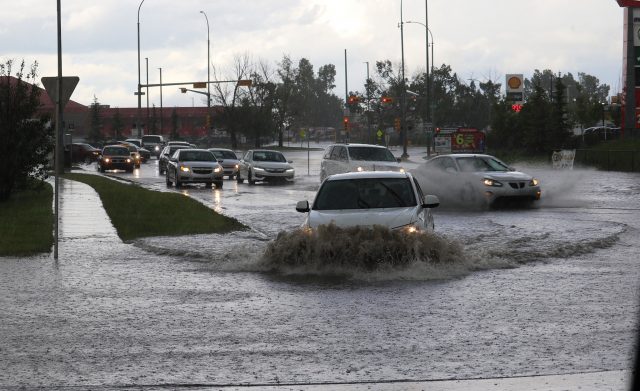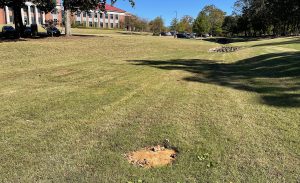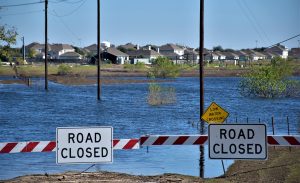
Impervious surfaces in cities and towns worsen urban flooding, which results in $9 billion in damages annually. UM researchers are studying how green stormwater infrastructure might lessen the effects of urban flooding. Image by Chris ‘CJ’ Johnson/Pixabay
OXFORD, Miss. – Cities and towns are crisscrossed and checkered by streaks and blotches of black and gray asphalt streets and concrete parking lots.
When downpours – remnants of a hurricane lumbering up the East Coast, a bomb cyclone unloading on California, an afternoon thunderstorm over New Orleans – pass over, these streets and lots quickly turn into rushing stormwater expressways, dumping all that water into already swollen streams.
The resulting flash floods wash away property and life, causing about $9 billion in damages nationwide annually, and carry tons of pollution and debris downstream.
All this water with no place to go is the focus of a group of University of Mississippi researchers who are studying how green stormwater infrastructure might lessen the impacts of the stronger and angrier rains of the 21st century on urban areas.
“Green stormwater infrastructure aims to infiltrate the stormwater in location to avoid damaging properties downstream or downhill,” said Cris Surbeck, chair and professor of civil engineering, and one of the researchers.
“Green stormwater infrastructure also captures and removes pollutants from that water. So those are some of the benefits, but green stormwater infrastructure is supposed to work together with gray stormwater infrastructure to infiltrate the water into the ground.”
So-called because it is designed to mimic nature and capture rainwater where it falls, green stormwater infrastructure reduces and treats stormwater at its source, according to the Environmental Protection Agency. It also provides multiple community benefits such as “reducing localized flooding, improving community aesthetics, improving economic health by increasing property values and providing jobs opportunities for small businesses, decreasing the economic and community impacts of flooding.”
“With green stormwater infrastructure, you infiltrate the water in place, right where it fell,” Surbeck said. “And it’s called green stormwater infrastructure for the environmental benefits, but also because it’s green in color most of the time because it’s vegetation. It’s rain gardens; it’s bioswales.
“It’s green and it’s attractive, and it has a lot of environmental benefits because you’re not carrying pollution far away. It can work with some of the older, traditional gray infrastructure to help manage urban flooding. It just takes a lot of different things to properly control stormwater.”
Gray infrastructure, which it is typically gray in nature, is traditional infrastructure such as curbs, gutters, drains and underground pipes that attempt to control nature and move water away as fast as possible from an area instead of using nature to solve drainage problems.
Joining Surbeck in working on how cities and towns can best use green stormwater infrastructure are Kristina Alexander, a research counsel II for the Mississippi-Alabama Sea Grant Legal Program, which is part of the Mississippi Law Research Institute, and Liya Abera, an Ole Miss graduate student pursuing her doctorate in environmental engineering.
“Flooding is the No. 1 natural disaster in the United States,” said Abera, who expects to graduate in August 2022 and wants to explore more about sustainable solutions for urban stormwater runoff problems with her research.
“Urban flooding is part of this flooding problem, and as cities grow, urban floods are getting worse. Green stormwater infrastructure is one way of reducing these flooding events.
The team’s research specifically addresses site-scaled use of green stormwater infrastructure, which should particularly help smaller cities.
“Because small cities typically do not have the finances to implement large-scale green stormwater infrastructure, they instead implement it on a site-by-site basis,” Abera said. “The information generated by this research will assist these communities in determining the most effective and economical method to implement green stormwater infrastructure on their sites and reduce the impacts from flooding events.
“Also, it will direct how to include regulations that incorporate the implementation of green stormwater infrastructure for development sites.”
Research that Finds Solutions
The threesome’s work began a few years ago from a university-supported research seed grant to analyze regulatory, technical and cost barriers to using green infrastructure for flood control in Oxford.
“The legal research involved looking at Oxford’s ordinances as well as those from other towns in the South to find ideas for best practices and easy fixes,” Alexander said. “While we were knee-deep in that project, we learned about an opportunity to do more research on the subject funded by the Mississippi-Alabama Sea Grant Consortium.
“The focus of that grant was on coastal cities, to help them adapt to increased stormwater impacts due to climate change by using green infrastructure.”
The group soon expanded its research to include six cities in the South: Oxford; Biloxi; Calhoun, Georgia; Orange Beach, Alabama; Ruston, Louisiana; and Sevierville, Tennessee.
The trio’s work on green stormwater infrastructure has led to one paper in the August 2021 issue of Environmental Challenges, titled “Evaluating the effect of city ordinances on the implementation and performance of green stormwater infrastructure.”
The paper states that even though green stormwater infrastructure has been commonly implemented in large cities, small and medium-sized cities also can prevent excess stormwater by incorporating green stormwater infrastructure in their ordinances for new developments and site retrofits.
“We looked at stormwater ordinances from more than a dozen cities across the United States to see what other areas were doing,” Alexander said. “The idea was to find best practices, and because we wanted the recommendations to be practical and useful, we narrowed the cities to these six that had similar populations and soil types, although we borrowed some ideas from other areas.”
Many studies have examined how green infrastructure helps communities, so the team narrowed its focus to studying how smaller towns with limited resources could reduce stormwater runoff by using green infrastructure on a site-by-site basis.
“It’s easy for a big city to find five acres to build a rain garden,” Alexander explained. “But smaller communities don’t have the resources for big gestures, so we researched what was cost-effective, and what was already in place via ordinances that could be adapted to other cities.”
For the city of Oxford, the researchers used computer simulations led by Abera to compare the effectiveness and costs of traditional stormwater management practices and green stormwater infrastructure using a proposed site in the city.
“Our job there was to take the stormwater design that was made for that site and see if we could change the design to include some green infrastructure like rain gardens, like permeable pavement, and see how the stormwater runoff would change by being more contained on the site because water would then be infiltrating the site,” Surbeck said.
“We also saw how the tanks for the traditional gray infrastructure could be decreased in size because now we have green infrastructure. That was all done through computer simulations.
Another part of the project involved reviewing the city’s stormwater ordinances and offering proposed language that city leaders can incorporate into regulations.

A group of UM researchers working on green stormwater infrastructure research teamed with the Facilities Management Department, UM Green Fund and two civil engineering majors to turn a stormwater detention basin near a School of Law parking lot into an infiltration basin. A series of dry wells – including one in the foreground – were drilled into the basin, and the holes were filled with gravel that will allow more room for water to infiltrate instead of going away in a pipe. Photo by Shea Stewart/Office of Research and Sponsored Programs
The researchers also were involved in creating a new green stormwater infrastructure on campus this past summer. The Facilities Management Department, the UM Green Fund and two civil engineering students, Nick Redwine and Dylan Walker, worked with the researchers to turn a stormwater detention basin near a School of Law parking lot into an infiltration basin.
“Working together with Facilities Management, we got some dry wells drilled into the basin, which are holes filled with gravel that will allow more room for water to infiltrate instead of going away in a pipe,” Surbeck said. “And so that’s something that we’ve been able to see immediately right here on campus.”
The research involving the Mississippi-Alabama Sea Grant Consortium is continuing, too, with the group examining implementation barriers for green infrastructure for coastal flood control, focused on the coastal cities of Biloxi and Orange Beach.
Moving Beyond Barriers
For all its benefits, there are barriers to towns and cities incorporating more green stormwater infrastructure measures. The green stormwater infrastructure needs to work well with existing gray infrastructure, and a large part of the country’s infrastructure – including how towns and cities remove stormwater – is crumbling.
Also, initial green stormwater infrastructure design and construction costs might be higher than traditional gray infrastructure, and it needs care and maintenance of its landscaping. And people need to be educated on what green stormwater infrastructure is to overcome culture and human behavior.
Some residents might see an existing green stormwater infrastructure site, such as a sunken rain garden, and pressure officials to create a soccer field or playground on the green space instead, Surbeck said.
“It means redesigning and rethinking how we want to develop our cities in putting in more green space,” she said. “It’s really a matter of people who don’t understand what the green infrastructure is there for or even what it is in the first place.”

Green stormwater infrastructure, so-called because it is designed to mimic nature and capture rainwater where it falls, reduces and treats stormwater at its source and could lead to less destruction from flash floods. Image by Ray Shrewsberry/Pixabay
Although these barriers exist, as green stormwater infrastructure is studied more, the more its benefits become apparent.
“Without green stormwater infrastructure, a city is not doing all it can to reduce water pollution,” Alexander said. “Wise use of green infrastructure allows a city to address its stormwater runoff obligations while also improving the livability of the community.
“Ordinances have to be popular to get passed, so the first step for officials is to show how green infrastructure can help make their city a better place. They can do this without ordinances by making changes to city-owned property. Put in rain gardens or even planters. Reduce curbs that prevent water from flowing into landscaped areas, especially in parking lots. This lets the water soak in, instead of flow away quickly.”


